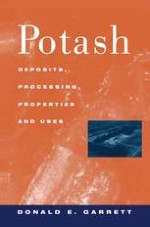1996 | OriginalPaper | Chapter
Potash Deposits
Author : Donald E. Garrett, PhD
Published in: Potash
Publisher: Springer Netherlands
Included in: Professional Book Archive
Activate our intelligent search to find suitable subject content or patents.
Select sections of text to find matching patents with Artificial Intelligence. powered by
Select sections of text to find additional relevant content using AI-assisted search. powered by
The number of potentially mineable and economically exploitable buried potash deposits is surprisingly large, and they are found scattered throughout the world. The “quality” of the deposits, however, varies widely in regard to their size (ore reserves), grade (mineable %K2O), and economic factors such as their location and the cost of mining and processing. The later features include the depth to the ore, thickness and uniformity of the potash bed, its slope, the strength and integrity of the overlying strata (to form a strong roof), the danger of water intrusion (flooding) and the cost of penetrating aquifer zones with the shafts, problems with combustible gasses or “rock bursts”, the amount of insolubles in the ore, the ease of “desliming”, the KCl-NaCl liberation size, and the amount of magnesium chloride (carnallite) or magnesium sulfate (kieserite, etc.) impurities present. The location is very important with respect to the deposit’s distance from the markets, the cost of transportation, Government royalties, taxes or fees, and possible special circumstances in selling the product (i.e., protective tariffs, local or controlled markets, reciprocal trade agreements, etc.). For the state-owned deposits there is often the over-riding desire to create jobs, reduce imports, and obtain foreign currency from exports. Also, there may be investment funds available at low interest rates or without the need for a normal return on the investment in order to promote a local industry.
